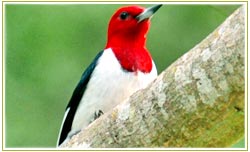 A Woodpecker belongs to a group of strong-billed birds that inhabit forests throughout the world except in Madagascar, Australia and on Oceanic Islands. It ranges in size from 6 to 19 inches in length. The plumage of Woodpeckers is a combination of black, white, brown, red, yellow and green.
A Woodpecker belongs to a group of strong-billed birds that inhabit forests throughout the world except in Madagascar, Australia and on Oceanic Islands. It ranges in size from 6 to 19 inches in length. The plumage of Woodpeckers is a combination of black, white, brown, red, yellow and green.
All Woodpeckers have large, thick-skulled heads and slender powerful necks. They have pointed bills that are hard and straight. Woodpeckers have short legs with long toes that have curved nails used for clinging to trees. One or two toes of each foot are usually turned backward to aid in grasping bark. Its steel-pointed tail feathers also help to brace the Woodpecker in its upright position in a tree trunk.
Insects dug from holes in trees comprise the chief diet component of Woodpeckers. Woodpeckers search for insects by listening, drilling holes with its bill and probing the holes with its long, barbed tongue. Woodpeckers are not regular migrants since there is usually an adequate supply of insect larvae and pupae under the bark of trees. Emigration is likely to take place when there is food shortage or over-population of a given Woodpecker specie.
Woodpeckers generally have a loud harsh voice. However, they often communicate by pecking rapidly on a hollow limb during the breeding season. Most Woodpeckers are cavity nesters. About two to eight roundish white eggs are laid.
 The Woodpecker is a large family with numerous species existing. One of the best known specie is the Hairy Woodpecker which lives throughout North America. It is about 5 inches long and is mostly black with white under parts and a white stripe down in the back. The male Hairy Woodpecker has a small red patch on the back of its head.
The Woodpecker is a large family with numerous species existing. One of the best known specie is the Hairy Woodpecker which lives throughout North America. It is about 5 inches long and is mostly black with white under parts and a white stripe down in the back. The male Hairy Woodpecker has a small red patch on the back of its head.
Another well known specie is the Red-headed Woodpecker which inhabits North America east of the Rocky Mountains. It is black and white with a red head and neck. It usually catches insects while in flight unlike other Woodpeckers. The breeding of Red-headed woodpeckers declines where forests mature and accelerates where beavers are increasing.
The largest North American specie is the Pileated Woodpecker. It is black with a red head crest and with white on the head, neck and wings. Pileated Woodpeckers may grow to a length of 19 inches and are considered one of the largest Woodpeckers found in North America. They are strong flyers and sometimes hop around on the ground.
 The Downy Woodpecker is a very small, black and white Woodpecker. Its length is about 5.75 inches and its bill is very short. The adult male has a red spot at the rear of the head.
The Downy Woodpecker is a very small, black and white Woodpecker. Its length is about 5.75 inches and its bill is very short. The adult male has a red spot at the rear of the head.
The Red-bellied Woodpecker is a familiar sight at bird feeders and in backyards. It is a medium to large-sized Woodpecker. Its belly is covered in light red wash in direct reference to its name, but the Red-bellied Woodpecker is easier to spot by the red on the back and top of its head. It is a vigorous competitor for nest holes with other Woodpeckers.
The Golden-fronted Woodpecker is a medium-sized specie measuring about 8.5 inches in length. It has a pale gray head, throat, breast and belly with a yellow nape patch and yellow spot above the bill. Its back and wings are barred with black and white. The Golden-fronted Woodpeckers are common in the parks and shade of Texas towns and cities.
There are at least two species of Woodpeckers that are sap suckers. These species do not feed primarily on insects but drink the sap that oozes from holes they drill in trees. Woodpeckers are classified as order Piciformes, family Picadae.